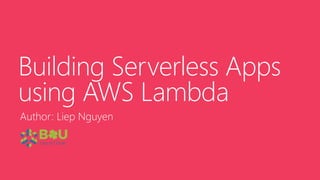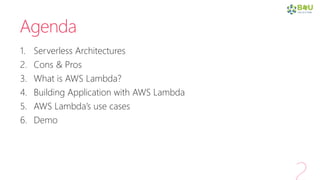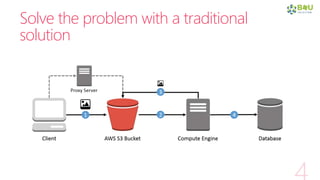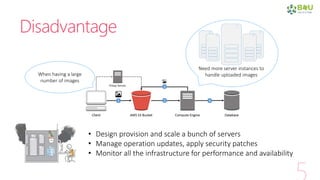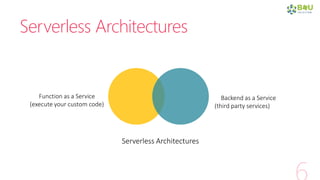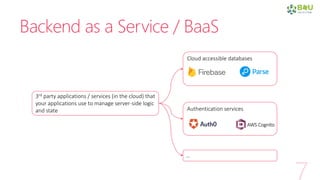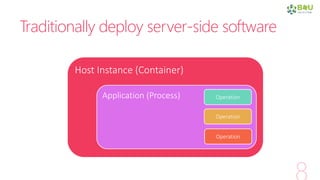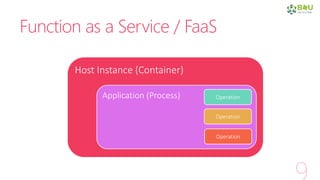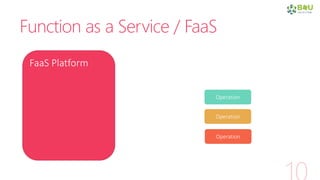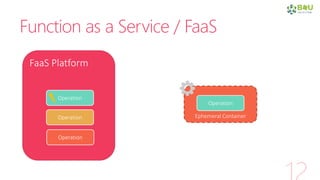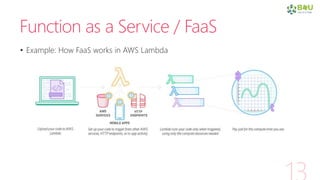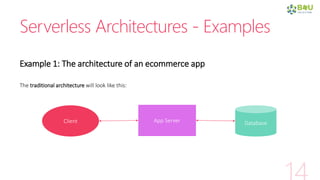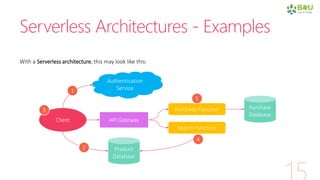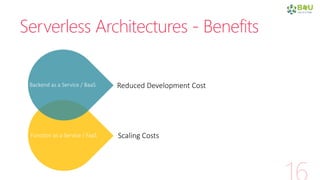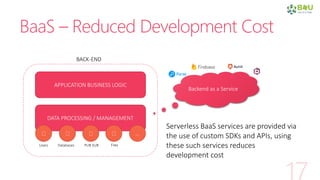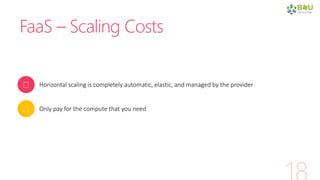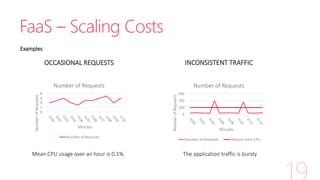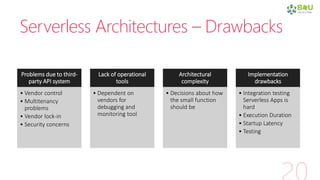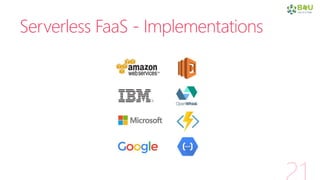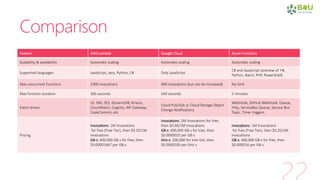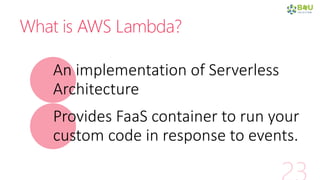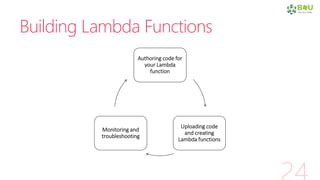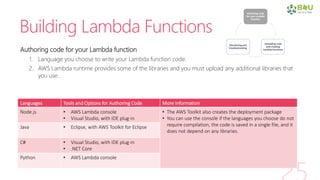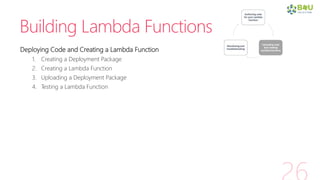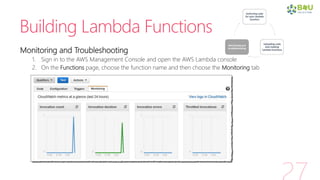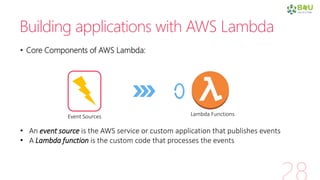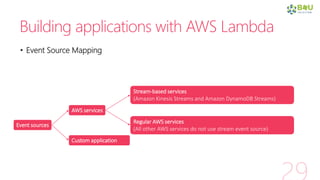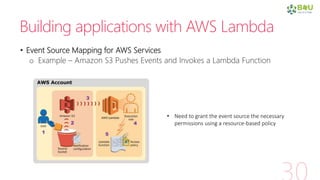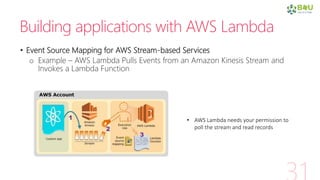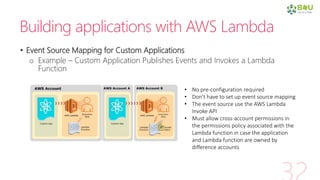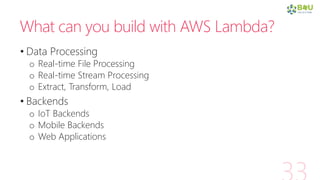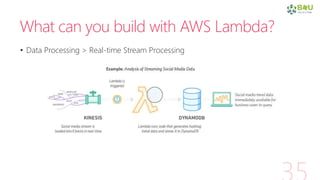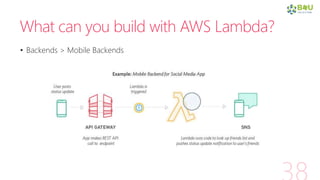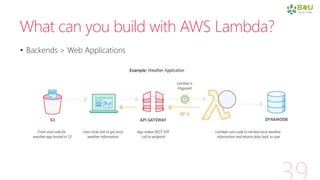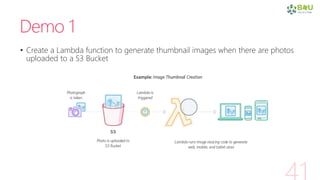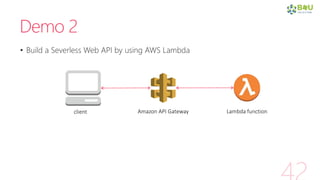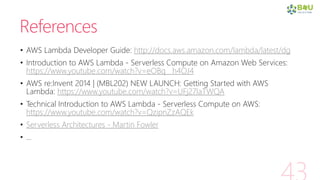Building serverless app_using_aws_lambda_b4usolution
- 1. Building Serverless Apps using AWS Lambda Author: Liep Nguyen
- 2. Agenda 1. Serverless Architectures 2. Cons & Pros 3. What is AWS Lambda? 4. Building Application with AWS Lambda 5. AWS Lambda’s use cases 6. Demo
- 3. Simple Problem • You want to generate thumbnail images when they are uploaded to a bucket
- 4. Solve the problem with a traditional solution
- 5. Disadvantage • Design provision and scale a bunch of servers • Manage operation updates, apply security patches • Monitor all the infrastructure for performance and availability When having a large number of images Need more server instances to handle uploaded images
- 6. Serverless Architectures Function as a Service (execute your custom code) Backend as a Service (third party services) Serverless Architectures
- 7. Backend as a Service / BaaS 3rd party applications / services (in the cloud) that your applications use to manage server-side logic and state Cloud accessible databases … Authentication services AWS Cognito
- 8. Traditionally deploy server-side software Host Instance (Container) Application (Process) Operation Operation Operation
- 9. Function as a Service / FaaS Host Instance (Container) Application (Process) Operation Operation Operation
- 10. FaaS Platform Function as a Service / FaaS Operation Operation Operation
- 11. FaaS Platform Function as a Service / FaaS Operation Operation Operation Operation Each operation listens to specific event
- 12. Ephemeral Container Function as a Service / FaaS FaaS Platform Operation Operation Operation Operation
- 13. Function as a Service / FaaS • Example: How FaaS works in AWS Lambda
- 14. Serverless Architectures - Examples Example 1: The architecture of an ecommerce app DatabaseClient App Server The traditional architecture will look like this:
- 15. Serverless Architectures - Examples Purchase Database Client With a Serverless architecture, this may look like this: Authentication Service API Gateway Purchase Function Search Function Product Database 1 2 4 5 3
- 16. Serverless Architectures - Benefits Reduced Development Cost Scaling CostsFunction as a Service / FaaS Backend as a Service / BaaS
- 17. BaaS – Reduced Development Cost APPLICATION BUSINESS LOGIC DATA PROCESSING / MANAGEMENT … Users Databases PUB SUB Files BACK-END Serverless BaaS services are provided via the use of custom SDKs and APIs, using these such services reduces development cost Backend as a Service
- 18. FaaS – Scaling Costs Horizontal scaling is completely automatic, elastic, and managed by the provider Only pay for the compute that you need
- 19. FaaS – Scaling Costs OCCASIONAL REQUESTS INCONSISTENT TRAFFIC 0 2 4 6 8 NumberofRequests Minutes Number of Requests Number of Requests 0 100 200 300 NumberofRequests Minutes Number of Requests Number of Requests Require more CPU Mean CPU usage over an hour is 0.1%. The application traffic is bursty Examples
- 20. Serverless Architectures – Drawbacks Problems due to third- party API system • Vendor control • Multitenancy problems • Vendor lock-in • Security concerns Lack of operational tools • Dependent on vendors for debugging and monitoring tool Architectural complexity • Decisions about how the small function should be Implementation drawbacks • Integration testing Serverless Apps is hard • Execution Duration • Startup Latency • Testing
- 21. Serverless FaaS - Implementations
- 22. Comparison Feature AWS Lambda Google Cloud Azure Functions Scalability & availability Automatic scaling Automatic scaling Automatic scaling Supported languages JavaScript, Java, Python, C# Only JavaScript C# and JavaScript (preview of F#, Python, Batch, PHP, PowerShell) Max concurrent functions 1000 invocations 400 invocations (but can be increased) No limit Max function duration 300 seconds 540 seconds 5 minutes Event-driven S3, SNS, SES, DynamoDB, Kinesis, CloudWatch, Cognito, API Gateway, CodeCommit, etc. Cloud Pub/Sub or Cloud Storage Object Change Notifications WebHook, GitHub WebHook, Queue, Http, ServiceBus Queue, Service Bus Topic, Timer triggers Pricing Invocations: 1M Invocations for free (Free Tier), then $0.20/1M Invocations GB-s: 400,000 GB-s for free, then $0.00001667 per GB-s Invocations: 2M Invocations for free, then $0.40/1M Invocations GB-s: 400,000 GB-s for tree, then $0.0000025 per GB-s GHz-s: 200,000 for tree tire, then $0.0000100 per GHz-s Invocations: 1M Invocations for free (Free Tier), then $0.20/1M Invocations GB-s: 400,000 GB-s for free, then $0.000016 per GB-s
- 23. What is AWS Lambda? An implementation of Serverless Architecture Provides FaaS container to run your custom code in response to events.
- 24. Building Lambda Functions Authoring code for your Lambda function Uploading code and creating Lambda functions Monitoring and troubleshooting
- 25. Building Lambda Functions Authoring code for your Lambda function 1. Language you choose to write your Lambda function code. 2. AWS Lambda runtime provides some of the libraries and you must upload any additional libraries that you use. Languages Tools and Options for Authoring Code More Information Node.js • AWS Lambda console • Visual Studio, with IDE plug-in • The AWS Toolkit also creates the deployment package • You can use the console if the languages you choose do not require compilation, the code is saved in a single file, and it does not depend on any libraries. Java • Eclipse, with AWS Toolkit for Eclipse C# • Visual Studio, with IDE plug-in • .NET Core Python • AWS Lambda console
- 26. Building Lambda Functions Deploying Code and Creating a Lambda Function 1. Creating a Deployment Package 2. Creating a Lambda Function 3. Uploading a Deployment Package 4. Testing a Lambda Function
- 27. Building Lambda Functions Monitoring and Troubleshooting 1. Sign in to the AWS Management Console and open the AWS Lambda console 2. On the Functions page, choose the function name and then choose the Monitoring tab
- 28. Building applications with AWS Lambda • Core Components of AWS Lambda: Event Sources Lambda Functions • An event source is the AWS service or custom application that publishes events • A Lambda function is the custom code that processes the events
- 29. Building applications with AWS Lambda • Event Source Mapping AWS services Custom application Regular AWS services (All other AWS services do not use stream event source) Stream-based services (Amazon Kinesis Streams and Amazon DynamoDB Streams) Event sources
- 30. Building applications with AWS Lambda • Event Source Mapping for AWS Services o Example – Amazon S3 Pushes Events and Invokes a Lambda Function • Need to grant the event source the necessary permissions using a resource-based policy
- 31. Building applications with AWS Lambda • Event Source Mapping for AWS Stream-based Services o Example – AWS Lambda Pulls Events from an Amazon Kinesis Stream and Invokes a Lambda Function • AWS Lambda needs your permission to poll the stream and read records
- 32. Building applications with AWS Lambda • Event Source Mapping for Custom Applications o Example – Custom Application Publishes Events and Invokes a Lambda Function • No pre-configuration required • Don’t have to set up event source mapping • The event source use the AWS Lambda Invoke API • Must allow cross-account permissions in the permissions policy associated with the Lambda function in case the application and Lambda function are owned by difference accounts
- 33. What can you build with AWS Lambda? • Data Processing o Real-time File Processing o Real-time Stream Processing o Extract, Transform, Load • Backends o IoT Backends o Mobile Backends o Web Applications
- 34. What can you build with AWS Lambda? • Data Processing > Real-time File Processing
- 35. What can you build with AWS Lambda? • Data Processing > Real-time Stream Processing
- 36. What can you build with AWS Lambda? • Data Processing > Extract, Transform, Load
- 37. What can you build with AWS Lambda? • Backends > IoT Backends
- 38. What can you build with AWS Lambda? • Backends > Mobile Backends
- 39. What can you build with AWS Lambda? • Backends > Web Applications
- 40. DEMO
- 41. Demo 1 • Create a Lambda function to generate thumbnail images when there are photos uploaded to a S3 Bucket
- 42. Demo 2 • Build a Severless Web API by using AWS Lambda client Amazon API Gateway Lambda function
- 43. References • AWS Lambda Developer Guide: http://docs.aws.amazon.com/lambda/latest/dg • Introduction to AWS Lambda - Serverless Compute on Amazon Web Services: https://www.youtube.com/watch?v=eOBq__h4OJ4 • AWS re:Invent 2014 | (MBL202) NEW LAUNCH: Getting Started with AWS Lambda: https://www.youtube.com/watch?v=UFj27laTWQA • Technical Introduction to AWS Lambda - Serverless Compute on AWS: https://www.youtube.com/watch?v=QzipnZzAQEk • Serverless Architectures - Martin Fowler • …
- 44. Q & A
- 45. THANKS FOR YOUR LISTENING
Editor's Notes
- #6: Provision a fleet proxy machines to capture uploads For each upload, enqueuer a job to process it Provision a second fleet of machines to read and process job Pick a deployment solution Plan capacity, accounting for fault tolerance, good long-term utilization, burst capacity, etc. Monitor 24x7 for capacity, health, security, etc. Migrate to new instances types over time, keeping OS and languages runtimes patched and up to date
- #13: Talk to audience that I just focus on function as a service
- #23: https://cloudacademy.com/blog/microsoft-azure-functions-vs-google-cloud-functions-fight-for-serverless-cloud-domination-continues/
